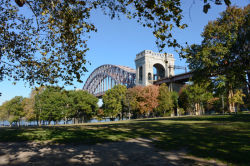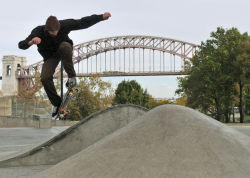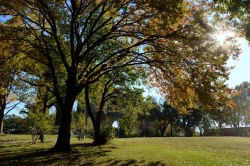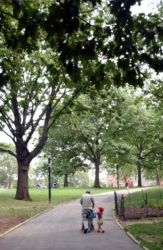Astoria Park
Astoria Park
Astoria Park, on the west shore of Queens, extends from south of the Triborough Bridge to north of the Hell Gate Bridge. With a panoramic view of the skyscrapers of midtown Manhattan in the south to the Hell Gate channel in the north, the scenery presents the diverse landscape of New York City. The Hell Gate channel, formed by faults deep underground, contains some of the deepest water in New York Harbor. Its treacherous reefs bear picturesque names such as “Hen and Chickens,” “Pot Rock,” “Bread & Cheese,” and “Bald Headed Billy.”
Throughout the centuries the stunning natural beauty of this location has attracted visitors and settlers. Before the arrival of European colonists, a trail passed by the site, and an Indian village flourished at Pot Cove. Local inhabitants grew maize on the shores, fished in Hell Gate, and drew water from Linden Brook, a small stream that still flows under Astoria Park South. In the mid-1600s the Dutch parceled out this land to various owners, including William Hallet whose grant embraced hundreds of acres. During the American Revolution, several British and Hessian regiments were stationed in the area. On November 25, 1780 the frigate Hussar and its five-million-dollar cargo sank to the bottom of Hell Gate, where despite some removal of cannons, the treasure still remains.
During the 19th century, fashionable families like the Barclays, Potters, Woolseys, and Hoyts located their country houses on the heights along the shore. Although attempts were made to remove the dangerous rocks in Hell Gate in the 1850s and 1870s, the waters were the site of New York City’s worst maritime disaster on June 15, 1904. En route to Long Island’s North Shore with the congregation of St. Mark’s German Lutheran Church on board, the steamer General Slocum caught fire. At least 1,021 passengers out of 1,300 burned to death on the ship or drowned in the turbulent waters of the East River before the ship grounded on North Brother Island.
As the Queens waterfront succumbed to industry after the Civil War, there emerged strong public sentiment for public access to the East River. In October 1913 the City of New York acquired more than 56 acres of land along the river for a park. It was originally called William J. Gaynor Park after the mayor (1910-1913) and later known as East River Park, but the Board of Aldermen officially named it Astoria Park in December 1913. Stephen Halsey, who founded the village of Astoria in 1839, named the area for his friend, fur merchant John Jacob Astor (1763-1848).
The new facility was equipped with two playgrounds, six tennis courts, an athletic field, three baseball diamonds, a wading pool, bandstand, public restroom and walks throughout. In 1926 community members gathered to dedicate the Astoria Park Memorial in tribute to the sons of Long Island City who died in World War I. Major improvements in Astoria Park were undertaken by Parks Commissioner Robert Moses and the Works Progress Administration during a hot summer in 1936. The stunning pool complex opened on July 4 of that year and hosted the swimming and diving trials for the U.S. Olympic Teams in 1936 and 1964.
The 56-acre park was expanded twice. Parks acquired a 4.5-acre parcel beneath the Triborough Bridge in 1937 and a 5-acre strip (known as Ralph DeMarco Park) along the East River in 1969. A three-part project renovated the park in the 1980s. Phase one rehabilitated the playground in the park’s southern section, the park fields, and the drainage system. Phase two restored the public restroom and installed new play equipment, swings, drinking fountains, and game tables. Phase three focused on restoration of the park’s northeast section and included repaving all the roads and walkways, rerouting pedestrian entrances, installing new benches, and planting trees, shrubs, and groundcover. The inviting setting of Astoria Park remains rich in history and symbolic of an ever-changing New York City.
Check out your park's Vital Signs
Clean & Safe
Green & Resilient
Empowered & Engaged Users
Share your feedback or learn more about how this park is part of a
Vital Park System










